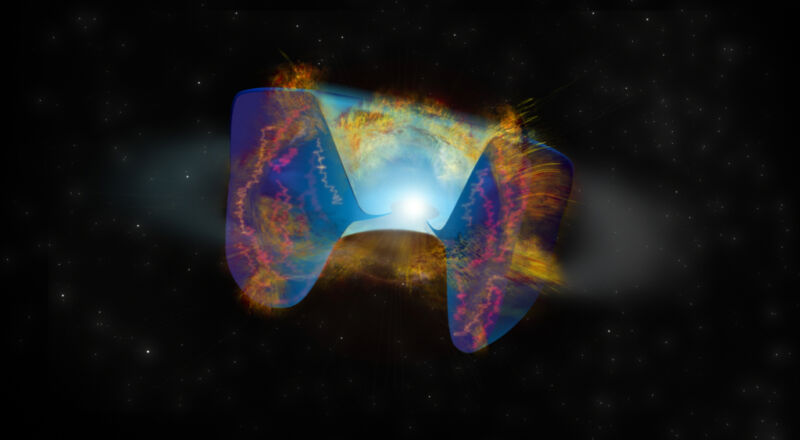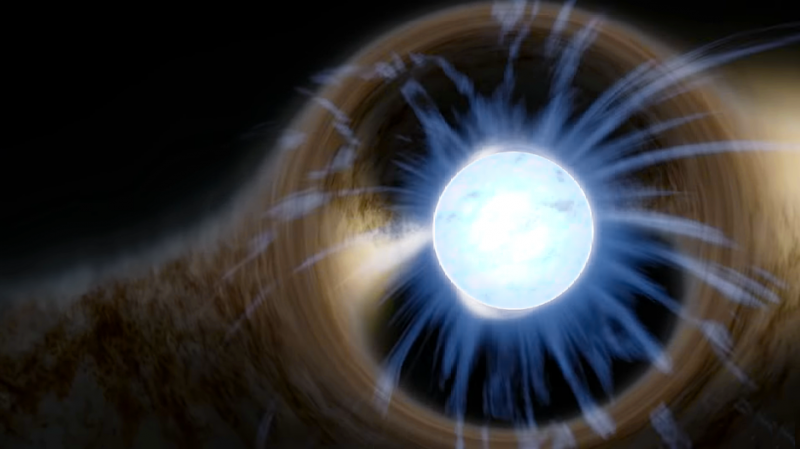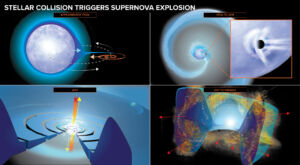
One of the stranger features of our Universe is the existence of what you might call "dual-core stars." Many stars exist as part of a multistar system, and in some cases, their orbits are extremely close. Couple that with the fact that stars can expand as they age, and you get a situation in which the outer edges of one star may engulf a second. Friction can then draw the stars' orbits closer, resulting in the core of both stars orbiting within a large, shared envelope of plasma.
Things can get more complicated still when you consider that the stars won't necessarily have life cycles that line up well—one of them could easily explode before the other, leaving behind a black hole or a neutron star. That can lead to some bizarre situations, like a star that replaces its core with a neutron star.
Now, researchers say they have probably found a more violent alternative to that merger. In this case, the neutron star didn't settle neatly into the core of its companion star. Instead, the companion star lost its outer layers to space and then saw its core disrupted in a way that caused it to explode.
Something new
The object in question, technically named VT J121001+495647, was identified by a team that compared two different surveys of the sky done at radio frequencies. The researchers looked for objects that were present when a survey was done between 2017 and 2018 and weren't present when the same area of sky was covered in a 1994–2005 survey. The brightest of these objects was VT J121001+495647.
A check of a hydrogen emission line from the object indicated that it was very broad instead of forming a sharp peak. This tells us that VT J121001+495647 has multiple components. Some are moving toward us, so the light they produce is blue-shifted, broadening the peak in that direction. Others are moving away from us and are thus broadening the peak in the red direction. The simplest explanation for this activity is that VT J121001+495647 is the debris of an exploded star, expanding out in all directions.
More accurately, we're seeing that debris slamming into material that was ejected from the star earlier, prior to its explosion. But the researchers calculate that the total amount of mass ejected earlier has to be at least the same as the mass of the Sun—a large amount of material, too large to be accounted for by a solar-wind-like process. So the material must have been ejected relatively recently for the supernova debris to be slamming into it already.
Complicating matters further, the team searched the archives for unusual events at the same location and came up with one: an X-ray burst picked up by an instrument on the International Space Station. The event was unusual in comparison to other X-ray bursts in that it was very luminous but brief, and it didn't extend to higher-energy wavelengths. The burst dates to three years prior to the imaging of VT J121001+495647, so it could have been from the supernova itself. But the duration and energy of the burst didn't match what we typically see from forming neutron stars or black holes.
Making sense of it all
Putting all the data together, we have evidence that the star ejected a lot of material a few years before it exploded, and the timing of this eruption may be linked to an X-ray burst. There are several ways to explain this phenomenon, but most don't seem to match up with the data especially well. For example, instabilities in the fusion reactions at the core of the star can cause an eruption, but they're only large enough to spit out a Sun's worth of material in the last few years before the explosion. And if that happened, the material would still be closer to where the star was than it actually is.
Interactions with a companion star could potentially produce a shell of material of the right density and distance. But the chances of them occurring so close to the star's explosion are extremely small.
So the researchers propose an alternative: The ejection of material did come through interactions with a companion object, and the interactions are what triggered the supernova.
The theoretical ideas behind that idea were explained in a series of papers released in the middle of the last decade. If the companion star has already exploded, it would then be in the form of a neutron star or black hole. If that body ended up inside the envelope of the normal star, it would form an accretion disk and jets, which would blast out a lot of the material in the outer layers of the star, forming the more distant material creating the radio signal.
If the compact companion object ends up close enough to the star's core, however, it could disrupt the core via tidal interactions. That's a problem because the orderly fusion of elements in the core provides the energy needed to keep gravity from collapsing the star. Mess with the core and the whole thing can come crashing down, producing a supernova. During this process, the infalling companion could have briefly formed an accretion disk and jets, which would then account for the X-ray burst found in the archives.
The star must have been massive enough to explode at some point anyway, but the disruption hastened the process.
There are a couple of other oddball objects we've seen in the past that could have been created by a similar mechanism. Unfortunately, we don't have the same wealth of data on them that we have for VT J121001+495647, so the timing of events can't be nailed down precisely. But with a good model of what to look for, don't be surprised if we're now able to identify others.
Science, 2021. DOI: 10.1126/science.abg6037 (About DOIs).



3175x175(CURRENT).thumb.jpg.b05acc060982b36f5891ba728e6d953c.jpg)


Recommended Comments
There are no comments to display.
Join the conversation
You can post now and register later. If you have an account, sign in now to post with your account.
Note: Your post will require moderator approval before it will be visible.